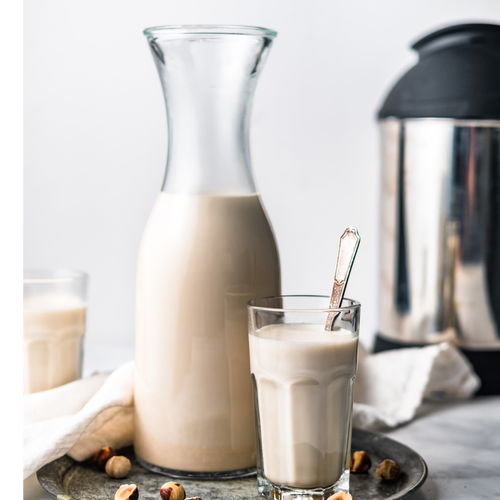

Ingredients
1 cup hazelnuts (unsoaked)
3 chopped, pitted dates or 1-2 tbsp maple syrup (optional)
Creamy Hazelnut Milk Recipe
Indulge your taste buds in the velvety goodness of hazelnut milk with our easy-to-follow recipe! Whether you're a seasoned plant-based enthusiast or just exploring dairy alternatives, making hazelnut milk at home is a delightful experience.
Servings: 5 cups
Ingredients
1 cup hazelnuts (unsoaked)
3 chopped, pitted dates or 1-2 tbsp maple syrup (optional)
Directions
Unique Features of Hazelnut Milk:
Here’s what sets hazelnut milk apart from other nut-based alternatives:
Creamy Texture:
- Hazelnut milk stands out with its velvety, creamy texture, offering a luxurious plant-based option.
Nutty Depth for Culinary Versatility:
- Unlike some nut milks, hazelnut milk adds a nuanced nutty depth, enhancing both sweet and savory dishes.
Comparative Brilliance:
- In comparison to almond and cashew milks, hazelnut milk uniquely combines texture and flavor, making it a standout choice.
Health Benefits:
Beyond its creamy texture and nutty richness, hazelnut milk offers an array of health benefits:
Heart-Healthy Properties:
- Hazelnuts are rich in monounsaturated fats, which have been associated with cardiovascular health. These fats contribute to a balanced cholesterol profile, supporting a heart-healthy lifestyle.
Low-Calorie Count:
- For those mindful of calorie intake, hazelnut milk proves to be a smart choice. With approximately 80-100 kcal/cup, it allows you to savor the goodness without unnecessary caloric load.
Dietary Fiber:
- Hazelnuts are a reliable source of dietary fiber, contributing to digestive health and providing a sense of fullness. A serving of hazelnut milk delivers 1-2g of fiber, making it a wholesome addition to your dietary fiber intake.
Vitamins and Minerals:
- Hazelnuts are a nutritional powerhouse, loaded with essential vitamins and minerals like Vitamin E, B vitamins, magnesium, and calcium. These vitamins and minerals support your immune system and keep your bones strong. Our recipe offers 4-6mg of Vitamin E (20-30% of your daily needs) and 100-150mg of calcium (10-15% of your daily needs)
Antioxidant Properties:
- Hazelnuts are packed with antioxidants! Including vitamin E and phytonutrients, which help combat oxidative stress in the body.
Note: Nutritional values can vary based on specific ingredients and sweeteners used in this recipe.
Nurturing Our Planet: Sustainability of Hazelnut Farming
We're all about making choices that feel good, and hazelnuts take the lead in the sustainable farming game.
Lower Water Footprint:
- Here is some info you can feel great about: Hazelnut trees generally require less water than some other nut-bearing trees, contributing to water conservation in regions where they are cultivated. This lower water footprint enhances the overall environmental sustainability of hazelnut farming.
Reduced Pesticide Usage:
- Hazelnuts are naturally resistant to certain pests, reducing the need for extensive pesticide applications.This means fewer pesticides are needed, which is awesome for the planet!
Certifications for Confidence:
- When you're picking hazelnuts, look out for the cool certifications like Rainforest Alliance, Fair Trade, or the organic labels. These badges ensure that the nuts you're enjoying come from places practicing ethical and eco-friendly farming.
Step by Step Recipe Instructions:
Ingredients:
- 1 cup hazelnuts (unsoaked)
- 3 chopped, pitted dates or 1-2 tbsp maple syrup (optional)
Without a Milk Maker:
- Place the hazelnuts and dates in a high-powered blender. If using maple syrup, add it at this stage.
- Blend the hazelnuts, dates, and optional maple syrup with water until smooth.
- Strain the mixture using a nut milk bag, cheesecloth, or fine mesh sieve into a bowl or pitcher.
- Transfer the strained hazelnut milk into a clean container, and refrigerate. Shake well before use as natural separation may occur.
Using a Milk Maker:
- Begin by placing the hazelnuts and dates in the filter basket. If opting for maple syrup, add it at this stage.
- Attach the filter basket to the top of your milk maker and secure it by twisting in the direction of the close arrow.
- Fill the milk maker base to the MIN line (5 cups) with water. If you're using maple syrup, add it at this stage. Attach the top.
- Plug in the milk maker and press the cow start button. It will go through 3 automatic stages. When the green light stops flashing, your hazelnut milk is ready!
FAQs:
For those curious minds seeking more insights, here's a compilation of frequently asked questions about hazelnut milk, ensuring you embark on your nutty adventure fully informed.
Q: Can I use roasted hazelnuts for this recipe?
A: Absolutely! Roasted hazelnuts add a deeper flavor to your hazelnut milk.
Q: Is hazelnut milk suitable for those with nut allergies?
A: Hazelnuts are tree nuts, so consult with your healthcare provider if you have nut allergies.
Q: Can I use this milk in baking recipes that call for dairy milk?
A: Yes! Hazelnut milk is a fantastic substitute for dairy milk in most recipes.
Q: Can I sweeten hazelnut milk with something other than dates or maple syrup?
A: Certainly! Experiment with agave syrup, honey, or your favorite natural sweetener.
Q: Can I reuse the hazelnut pulp leftover from the milk-making process?
A: Absolutely! Get creative and add it to oatmeal, smoothies, or use it as a base for energy bites.